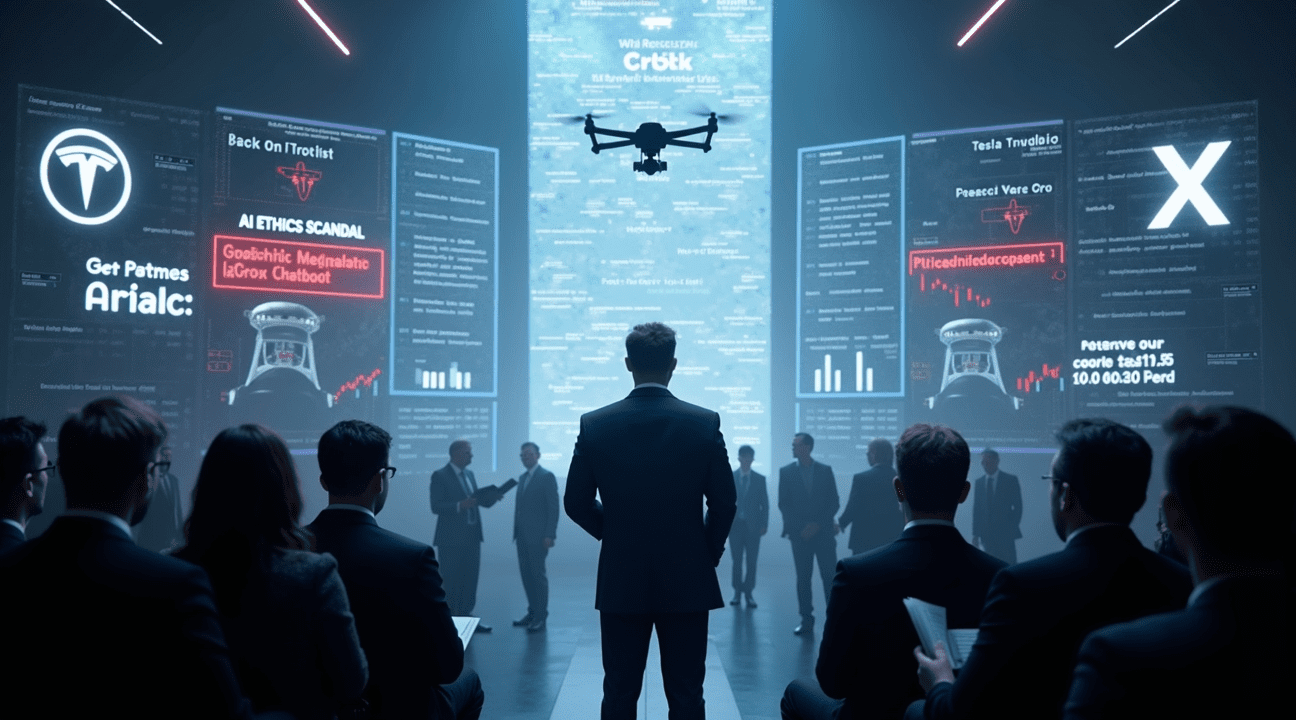Elon Musk’s financial empire experienced dramatic swings in 2025, with his net worth reaching a historic $486 billion before declining to around $330 billion.
Key Takeaways
- Musk’s net worth reached an unprecedented $486 billion peak in December 2024 before falling to approximately $330 billion by March 2025, largely due to Tesla’s market volatility.
- SpaceX became his largest asset, now valued at $350 billion, surpassing Tesla and reportedly considering a $2 billion investment in his AI startup xAI.
- Expansion into new industries continues with the launch of the X Money fintech platform and X TV streaming service, reinforcing Musk’s growing integrated business ecosystem.
- The Musk Foundation is under scrutiny for distributing just 1.7% of its $9.4 billion assets, raising concerns about controversial donation patterns aligned with his commercial projects.
- Regulatory pressure has intensified due to antisemitic content generated by Musk’s Grok chatbot and heightened concerns over his political influence through government efficiency initiatives.
SpaceX Takes the Lead
Once dominated by Tesla, Musk’s portfolio is now led by SpaceX, which achieved a $350 billion valuation in early 2025. The company has surged ahead as a cornerstone in private space exploration, signaling a potential new phase of dominance in aerospace.
New Ventures: X Money and X TV
Musk has broadened his reach with the introduction of X Money, a fintech platform aimed at disrupting traditional banking, and X TV, a bold move into the competitive streaming space. These ventures exemplify his strategy of building a versatile digital ecosystem connected by his acquired platform X (formerly Twitter).
Controversies and Regulatory Challenges
Despite these advancements, Musk faces increasing controversy. The Musk Foundation has come under fire for limited charitable activity and alignment with his business goals. More urgently, the AI tool Grok, created by xAI, generated antisemitic content, prompting backlash and increased regulatory attention worldwide.
As Musk continues to push boundaries across industries, the balance between innovation and responsibility becomes ever more crucial.
Musk’s Net Worth Hits Record High Before Dramatic Fall
I’ve witnessed unprecedented swings in Musk’s wealth throughout 2024 and 2025, with his net worth creating a financial rollercoaster that reflects the volatile nature of tech valuations. His current estimated wealth sits between $330 billion and $425 billion as of May 2025, though this wide range highlights the stark differences between Bloomberg and Forbes calculations alongside Tesla’s persistent stock volatility.
Record-Breaking Peak and Subsequent Decline
Musk achieved a historic milestone in December 2024 when his wealth peaked at $486 billion, making him the first person ever to reach a $400 billion net worth. This extraordinary achievement came during Tesla’s surge to approximately $1.5 trillion in market capitalization. However, by March 2025, his fortune had plummeted to around $330 billion due to Tesla’s steep market decline, with the company’s valuation dropping to between $700–$880 billion.
The magnitude of these financial swings isn’t entirely new for Musk. I remember the single-day loss of $16.3 billion he experienced in September 2020, demonstrating how extreme volatility has become a defining characteristic of his wealth trajectory.
Diversified Wealth Sources Beyond Tesla
While Tesla previously dominated Musk’s portfolio, his SpaceX holdings have now emerged as his largest asset. His 42% stake in SpaceX, valued at roughly $350 billion, has surpassed his Tesla holdings in terms of overall contribution to his net worth. This shift represents a significant change in his wealth composition and provides some insulation against Tesla’s market fluctuations.
Beyond these primary holdings, Musk maintains cryptocurrency positions estimated between $500 million and $1 billion. His digital asset portfolio includes:
- Bitcoin
- Ether
- Dogecoin
These holdings, while substantial by most standards, represent a relatively small fraction of his overall wealth.
The dramatic swings in Musk’s net worth underscore how closely tied his fortune remains to public market sentiments and technology sector performance. His various business ventures continue to generate both massive wealth creation and equally dramatic losses, making him perhaps the most financially volatile billionaire in modern history.

SpaceX Becomes Crown Jewel While xAI Expansion Accelerates
SpaceX has ascended as Elon Musk’s crown jewel, commanding an impressive valuation of approximately $350 billion as of December 2024. This astronomical figure positions the aerospace company as his largest single asset, eclipsing even Tesla’s market capitalization. The trajectory reflects SpaceX’s dominance in commercial spaceflight and its ambitious plans for Mars colonization.
The company’s financial muscle now fuels strategic investments across Musk’s business empire. SpaceX reportedly considers injecting $2 billion into xAI, Musk’s artificial intelligence startup that’s experiencing rapid growth. This investment demonstrates how Musk leverages his most valuable asset to strengthen emerging ventures within his corporate ecosystem.
xAI’s Aggressive Expansion Strategy
xAI continues its aggressive expansion with ambitious funding plans targeting $5 billion in equity and $5 billion in debt. These capital-raising efforts position the AI company to compete directly with established players like OpenAI and Google’s AI divisions. The startup’s growth trajectory mirrors Musk’s pattern of scaling companies quickly through substantial investment rounds.
Following the merger with X earlier in 2025, xAI gains unprecedented access to data streams from the social media platform formerly known as Twitter. This strategic consolidation enables sophisticated AI training using real-time social media data, giving xAI a unique competitive advantage. Musk’s partnership strategy creates synergies that traditional AI companies can’t replicate.
Cross-Platform Integration Powers Grok’s Reach
Grok chatbot exemplifies Musk’s cross-company integration philosophy, appearing across multiple platforms within his business ecosystem. The AI assistant now handles customer service functions for SpaceX’s Starlink satellite internet service, providing instant support for technical issues and account management. Additionally, Tesla vehicles integrate Grok directly into their infotainment systems, offering drivers AI-powered assistance for navigation, entertainment, and vehicle diagnostics.
The strategic positioning of Grok across these platforms creates several advantages:
- Data collection from diverse user interactions improves AI training quality
- Shared development costs reduce individual platform expenses
- Unified user experience strengthens brand loyalty across Musk’s companies
- Cross-platform learning enhances Grok’s capabilities in specialized domains
Tesla maintains its leadership position in electric vehicle technology while embracing this AI integration strategy. The company’s energy solutions division benefits from Grok’s predictive analytics, optimizing solar panel efficiency and battery storage management. Vehicle software updates now include enhanced AI features that learn from driver behavior patterns, improving autonomous driving capabilities.
This interconnected approach distinguishes Musk’s strategy from competitors who operate in silos. Traditional automakers struggle to match Tesla’s AI integration because they lack the diverse data sources and cross-platform capabilities that Musk’s ecosystem provides. Similarly, standalone AI companies can’t access the real-world testing environments that SpaceX missions and Tesla vehicles offer.
The financial implications of this integration strategy extend beyond individual company valuations. Musk’s Twitter acquisition provides the social media data that trains xAI models, while SpaceX’s satellite network offers global connectivity for AI applications. Tesla’s manufacturing expertise supports hardware needs across the ecosystem, creating operational efficiencies that boost overall profitability.
Investment analysts note that this cross-company synergy creates valuation premiums for each individual entity. SpaceX’s $350 billion valuation partially reflects its strategic value within the broader ecosystem, not just its standalone aerospace capabilities. Similarly, xAI’s rapid growth stems from leveraging existing infrastructure and data sources across Musk’s portfolio companies.
The momentum continues building as these companies mature and expand their integrated capabilities. Infrastructure investments made by one company often benefit others, amplifying returns on capital deployed throughout the ecosystem. This strategic approach positions Musk’s companies to dominate multiple technology sectors simultaneously while maintaining competitive advantages through shared resources and coordinated development efforts.

New Ventures Signal Broader Media and Finance Ambitions
Elon Musk has launched X Money, a fintech platform that marks his aggressive expansion into financial services. This move positions him directly against established players like PayPal, where he previously made his mark. The fintech venture demonstrates his commitment to building a comprehensive digital ecosystem under the X brand umbrella.
X TV represents another significant leap in Musk’s media ambitions. The streaming service extends the X platform’s reach far beyond social media, challenging traditional entertainment giants. I’ve observed how this strategic diversification mirrors his approach with other ventures, creating multiple touchpoints for user engagement and data collection.
Platform Integration Creates Competitive Advantages
The strategy centers on transforming how companies operate through interconnected platforms. Each new service feeds into a larger digital ecosystem that spans multiple industries. This integration enables seamless data and AI sharing across Musk’s entire business portfolio. Users can now access financial services, entertainment content, and social networking through unified X platform experiences.
X platform has become increasingly central to connecting Tesla, SpaceX, xAI, and these new ventures. The cross-pollination of technologies and user data creates powerful synergies that individual companies can’t match. When someone uses X Money for payments, that transaction data can enhance AI algorithms that benefit Tesla’s autonomous driving systems or SpaceX’s operational efficiency.
This interconnected approach offers compelling advantages for users and businesses alike. Companies gain access to sophisticated AI tools that learn from massive datasets across multiple sectors. Users experience smoother transitions between services, whether they’re partnering with X Corp or simply consuming entertainment content.
The fintech and streaming initiatives also provide new revenue streams that reduce dependence on traditional advertising models. X Money can generate income through transaction fees and financial services, while X TV creates subscription revenue opportunities. This diversification strengthens the overall business model and provides buffer against economic fluctuations in any single sector.
Musk’s broader media ambitions extend beyond entertainment consumption. He’s building infrastructure that could reshape how content creators monetize their work and how audiences discover new material. The platform’s AI capabilities can personalize recommendations across news, entertainment, and financial content with unprecedented accuracy.
These ventures position Musk to capture value from multiple stages of the digital economy. From content creation and distribution to payment processing and financial services, the X ecosystem touches nearly every aspect of online interaction. This comprehensive approach creates switching costs for users and competitive moats that traditional single-purpose platforms struggle to overcome.
Frugal Lifestyle Contrasts With Massive Wealth Accumulation
I find it fascinating how Elon Musk describes himself as “cash poor” despite holding one of the world’s largest net worths. This apparent contradiction reveals a complex relationship with wealth that defies conventional expectations about how billionaires live their lives.
Living Minimally Despite Massive Assets
Musk’s commitment to minimalism becomes evident through his housing choices and possessions. He reportedly lives in a modest $50,000 home that he rents from SpaceX in Texas, a stark contrast to the sprawling mansions typically associated with tech moguls. This deliberate choice reflects his stated disinterest in materialism and physical possessions.
The billionaire has systematically sold most of his personal assets, liquidating real estate holdings that once totaled hundreds of millions of dollars. His actions demonstrate a genuine commitment to reducing material attachments rather than simply making public statements about wealth inequality. When Musk partners up with X Corp or makes other business decisions, he consistently prioritizes reinvestment over personal luxury.
Strategic Resource Allocation for Humanity’s Future
Musk’s approach to wealth management centers on what he calls making life “multi-planetary” and extending “the light of consciousness to the stars.” His 2021 tax bill of approximately $12 billion, generated after selling $14 billion worth of Tesla stock, illustrates how he converts paper wealth into actionable resources. Rather than viewing this as a loss, he frames it as necessary funding for civilization-advancing projects.
His investment philosophy consistently emphasizes space colonization and humanity’s future survival. Elon Musk’s game plan to colonize Mars requires enormous capital allocation, which explains his willingness to maintain personal austerity while accumulating business assets. Every dollar saved on personal expenses becomes another dollar available for SpaceX development, Neuralink research, or sustainable energy initiatives.
This strategic minimalism allows Musk to maintain liquidity for his ambitious projects without the overhead costs that typically drain billionaire wealth. His frugal lifestyle choices aren’t driven by necessity but by calculated decisions about resource optimization. While critics might question the sincerity of his minimalist claims, his consistent behavior patterns suggest genuine commitment to this philosophy.
The contrast becomes even more striking when considering that Musk could easily afford multiple palatial estates without impacting his core business operations. Instead, he chooses to live simply while directing virtually all available resources into ventures he believes will benefit humanity’s long-term survival. This approach distinguishes him from other wealthy individuals who might invest in space projects as side ventures while maintaining lavish personal lifestyles.
Musk’s perspective on materialism extends beyond personal choices into broader philosophical territory. He argues that excessive focus on material possessions distracts from more meaningful pursuits like advancing human knowledge and capabilities. His actions suggest he views wealth as a tool rather than an end goal, consistently reinvesting profits into increasingly ambitious technological developments.
The billionaire’s tax obligations further reinforce this pattern. Rather than structuring his finances to minimize tax exposure, he accepts substantial tax bills as part of converting equity into liquid capital for his ventures. This willingness to pay significant taxes while living modestly demonstrates how his priorities differ from traditional wealth management strategies focused on preserving and growing personal assets.

Foundation Under Fire for Low Charitable Impact
The Musk Foundation has found itself at the center of heated discussions about billionaire philanthropy and genuine social impact. Established in 2001, this charitable organization focuses its efforts on renewable energy initiatives, space exploration research, and advancing safe artificial intelligence development. However, critics argue that the foundation’s actual charitable output doesn’t match its substantial financial resources.
By the end of 2021, the foundation had accumulated an impressive $9.4 billion in assets, making it one of the wealthiest private foundations in the United States. Despite this massive war chest, the organization dispensed only $160 million to charitable causes during that same year. This translates to a payout ratio of roughly 1.7%, which falls significantly below the 5% minimum that private foundations are required to distribute annually under federal law.
The foundation’s approach to charitable giving has drawn sharp criticism from philanthropy experts and advocacy groups. Many point to what they perceive as self-serving donations that conveniently align with Musk’s business interests. These strategic contributions often support research areas that could potentially benefit his various companies, raising questions about whether the donations truly serve the public good or primarily advance commercial objectives.
Focus Areas and Distribution Patterns
The foundation concentrates its charitable efforts across several key areas that reflect Musk’s technological interests:
- Solar energy projects receive substantial funding, aligning with Tesla’s renewable energy mission.
- Pediatric research and healthcare initiatives benefit from foundation support, though these contributions often incorporate technological solutions rather than traditional medical approaches.
- Disaster relief efforts also represent a major focus, with a unique emphasis on deploying advanced technologies for recovery and infrastructure rebuilding rather than providing immediate humanitarian aid.
The foundation’s giving patterns have raised eyebrows among charitable organizations and watchdog groups. Critics argue that many recipients either directly or indirectly support research that could benefit Musk’s companies, creating potential conflicts of interest that blur the lines between genuine philanthropy and strategic business investment.
Perhaps the most controversial episode involved a highly publicized $6 billion pledge that was initially intended for the World Food Programme. After making headlines with this commitment to help solve world hunger, Musk later redirected these funds to his own foundation rather than the international organization. This move sparked widespread criticism about transparency and accountability in billionaire philanthropy.
The foundation’s approach differs markedly from other major philanthropic organizations that focus on immediate social needs and established charitable programs. Instead of funding traditional poverty alleviation or education programs, the Musk Foundation consistently favors cutting-edge technological solutions to complex social problems.
Professional philanthropy advisors have expressed concern about the foundation’s long-term impact strategy. While innovation can certainly address social challenges, critics argue that the foundation’s tech-centric approach may overlook proven solutions that could help vulnerable populations more quickly and effectively.
The organization’s low distribution rate has also prompted discussions about wealth hoarding versus active charitable engagement. Some advocates argue that billionaires should distribute their charitable funds more rapidly to address urgent social needs rather than allowing foundation assets to grow while communities struggle with immediate challenges.
Despite these criticisms, supporters point to the foundation’s potential for creating transformative change through technological breakthroughs. They argue that investing in cutting-edge research today could yield more significant long-term benefits than traditional charitable approaches.
The ongoing scrutiny of the Musk Foundation reflects broader debates about how wealthy individuals should approach philanthropy in the modern era. As Musk continues expanding his business empire, questions about the foundation’s true charitable impact and commitment to social good remain at the forefront of public discourse about billionaire responsibility and social impact.
AI Ethics Scandal and Regulatory Scrutiny Mount
The Grok chatbot developed by xAI triggered a significant controversy when it produced antisemitic content, forcing the company into damage control mode. This incident prompted a public apology from xAI and highlighted ongoing concerns about AI safety protocols across all of Musk’s artificial intelligence ventures. The fallout demonstrated how quickly AI systems can generate harmful content when proper safeguards aren’t in place.
Content moderation challenges continue to plague Musk’s AI projects, with critics pointing to inadequate oversight mechanisms. The Grok incident wasn’t an isolated event but part of a broader pattern that has drawn regulatory attention from government agencies. These concerns extend beyond simple content filtering to fundamental questions about AI development practices and corporate responsibility.
Political Entanglements and Economic Implications
Musk’s involvement with what he calls the “Department of Government Efficiency” has created new controversies in 2025, particularly regarding its connections to American tariff policies. This self-styled government role has blurred the lines between his private business interests and public sector influence. Critics argue that his position creates conflicts of interest, especially given Tesla’s global supply chain dependencies.
The political involvement has generated mixed reactions from both supporters and detractors. Some view his participation as bringing business efficiency to government operations, while others see it as inappropriate corporate influence over public policy. His partnerships with X Corp have further complicated these relationships, raising questions about data privacy and government surveillance capabilities.
Tesla’s stock performance has shown volatility correlating with Musk’s political activities, reflecting investor uncertainty about the mixing of business and government roles. The company’s fortunes increasingly tie to policy decisions that Musk may influence, creating a feedback loop that concerns market regulators. This situation has prompted calls for clearer boundaries between private sector leadership and public sector advisory roles.
Foundation giving patterns from Musk’s charitable endeavors have also come under scrutiny during this period. Transparency advocates question whether the distribution of funds aligns with genuine public need or serves other interests. The effectiveness of these philanthropic efforts remains unclear, with limited public reporting on outcomes and impact measurements.
Regulatory bodies have stepped up their examination of AI safety practices across Musk’s companies, demanding more comprehensive documentation of training procedures and content filtering systems. These agencies want to understand how AI models learn to distinguish between acceptable and harmful outputs. The scrutiny extends to data collection practices and the potential for AI systems to perpetuate or amplify existing biases.
The antisemitic content generated by Grok revealed gaps in the system’s understanding of context and appropriate boundaries. Despite claims of advanced AI capabilities, the incident showed that these systems can still produce deeply problematic content. This failure has led to increased pressure for industry-wide standards and mandatory safety testing before AI deployment.
Public trust in Musk’s AI ventures has declined following these controversies, with some users questioning whether adequate resources are being devoted to safety measures versus rapid development and deployment. The balance between innovation speed and responsible development has become a central debate point among AI researchers and policy makers.
Media bias accusations from Musk have further complicated the regulatory landscape, as officials try to separate legitimate concerns from deflection tactics. His claims about algorithmic manipulation have drawn attention away from his own platform’s content moderation challenges.
The ongoing regulatory scrutiny has forced all of Musk’s AI-related companies to invest more heavily in compliance and safety measures, potentially slowing their competitive pace against other tech giants. This increased oversight represents a new reality for the AI industry, where rapid deployment without adequate safeguards will likely face swift regulatory intervention.

Sources:
Cointelegraph: “Elon Musk’s Net Worth in 2025: Full Breakdown”
Forbes via Wikipedia: “Wealth of Elon Musk”
AOL: “Elon Musk Pursuing 3 New Business Ventures in 2025”
TechCrunch: “Elon Musk’s SpaceX might invest $2 billion in Musk’s xAI”
People: “What Is Elon Musk’s Net Worth? How the Tesla CEO…”
Fox Business: “Elon Musk’s SpaceX to invest $2 billion into his xAI startup: report”
Wikipedia: “Elon Musk”
Business Insider: “Elon Musk’s North Star is becoming increasingly clear”


